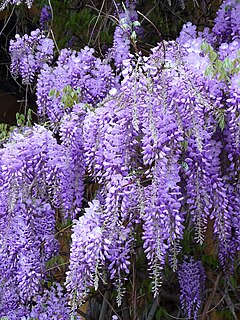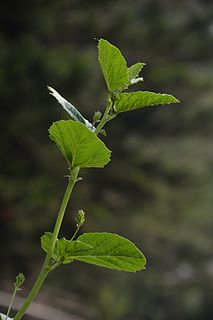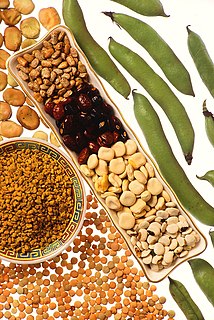
Wisteria is a genus of flowering plants in the legume family, Fabaceae (Leguminosae), that includes ten species of woody climbing bines that are native to China, Korea, and Japan and as an introduced species to the Eastern United States. Some species are popular ornamental plants. An aquatic flowering plant with the common name wisteria or 'water wisteria' is in fact Hygrophila difformis, in the family Acanthaceae.

Psoralea is a genus in the legume family (Fabaceae). Although most species are poisonous, the starchy roots of P. esculenta and P. hypogaea are edible. A few species form tumbleweeds.
Isoflavones are substituted derivatives of isoflavone, a type of naturally occurring isoflavonoids, many of which act as phytoestrogens in mammals. Isoflavones are produced almost exclusively by the members of the Fabaceae family.

A tumbleweed is a structural part of the above-ground anatomy of a number of species of plants, a diaspore that, once it is mature and dry, detaches from its root or stem, and rolls due to the force of the wind. In most such species, the tumbleweed is in effect the entire plant apart from the root system, but in other plants, a hollow fruit or an inflorescence might serve the function. Tumbleweed species occur most commonly in steppe and arid ecosystems, where frequent wind and the open environment permit rolling without prohibitive obstruction.

Psoralea esculenta, common name prairie turnip, is an herbaceous perennial plant native to prairies and dry woodlands of central North America, which bears a starchy tuberous root edible as a root vegetable. The plant is also known as Pediomelum esculentum. English names for the plant include tipsin, teepsenee, breadroot, breadroot scurf pea, large Indian breadroot and pomme blanche. The prairie turnip was a staple food of the Plains Indians.

Olearia argophylla is a species of flowering plant in the Asteraceae family. Its common names are musk daisybush, musktree, muskwood and silvershrub. It is found in Australia, specifically in New South Wales, Tasmania and Victoria. It grows as a tall shrub or tree characteristic of wet sclerophyll forest. Its leaves are large and broad, coarsely toothed, green on top and silver-white underneath. The grain of the wood is mainly straight, but burls near the base of the tree are prized for their brown swirls that often suggest the appearance of small faces or animals peering out of the wood, making them highly sought after by woodworkers.

Psoralea pinnata is an erect evergreen shrub or small tree that grows to a height of 1.5 metres (5 ft) to 4 metres (13 ft) tall.

Tithonia is a genus of flowering plants in the sunflower tribe within the Asteraceae family.

Cinnamomum iners is a tree species in the family Lauraceae described by Reinwardt and Blume. No subspecies are listed in the Catalogue of Life. It occurs naturally in Sri Lanka, India, Bangladesh, Myanmar, Thailand, Laos, Cambodia, Vietnam, Malaysia, Indonesia, the Philippines and southern China and south-eastern Tibet.

Psoralea corylifolia (Babchi) is an important plant in the Indian Ayurveda and Tamil Siddha systems of medicine, and also Chinese medicine. The seeds of this plant contain a variety of coumarins including psoralen. The seeds have a variety of traditional medicinal uses, but the specific role of psoralen in these uses is unknown.
Nitrospirae is a phylum of bacteria. It contains only one class, Nitrospira, which itself contains one order (Nitrospirales) and one family (Nitrospiraceae). It includes multiple genera, such as Nitrospira, the largest. The first member of this phylum, Nitrospira marina, was discovered in 1985. The second member, Nitrospira moscoviensis, was discovered in 1995.

The World's 25 Most Endangered Primates is a list of highly endangered primate species selected and published by the International Union for Conservation of Nature Species Survival Commission Primate Specialist Group, the International Primatological Society (IPS), and Conservation International (CI). The 2012–2014 list added the Bristol Conservation and Science Foundation (BCSF) to the list of publishers. The IUCN/SSC PSG worked with CI to start the list in 2000, but in 2002, during the 19th Congress of the International Primatological Society, primatologists reviewed and debated the list, resulting in the 2002–2004 revision and the endorsement of the IPS. The publication has since been a joint project between the three conservation organizations and has been revised every two years following the biannual Congress of the IPS. Starting with the 2004–2006 report, the title changed to "Primates in Peril: The World's 25 Most Endangered Primates". That same year, the list began to provide information about each species, including their conservation status and the threats they face in the wild. The species text is written in collaboration with experts from the field, with 60 people contributing to the 2006–2008 report and 85 people contributing to the 2008–2010 report. The 2004–2006 and 2006–2008 reports were published in the IUCN/SSC PSG journal Primate Conservation, while the 2008–2010 and 2010-2012 report were published as independent publications by all three contributing organizations.

The tribe Psoraleeae is one of the subdivisions of the plant family Fabaceae. Recent phylogenetics has this tribe nested within tribe Phaseoleae.

Agapanthia violacea is a species of flat-faced longhorn beetle belonging to the family Cerambycidae, subfamily Lamiinae.

Bakuchiol is a meroterpene in the class terpenophenol. It is found in Psoralea corylifolia and in Otholobium pubescens.

Enceliopsis argophylla, commonly known as the silverleaf sunray, is a North American species of flowering plant in the daisy family. Other common names include nakedstem sunray and naked-stemmed daisy. It is native to the southwestern United States: Arizona, Nevada, and Utah, and can be seen a short distance east of Las Vegas, Nevada.
Anacampsis psoraliella is a moth of the Gelechiidae family. It was described by William Barnes and August Busck in 1920. It is found in North America, where it has been recorded from Iowa.

Euphorbia ferox is a species of plant in the Euphorbiaceae family.

Psoralea glandulosa is a herb species in the genus Psoralea found in Perú and Chile in South America and also in the United States.

Drupanol is a naturally occurring phenol that has been isolated from the seeds of Psoralea drupaceae. Although drupanol is sometimes said to be the same compound as bakuchiol, the two compounds are in fact distinct; they have the same molecular formula and weight but different chemical structures and hence are structural isomers. Drupanol has been found to possess androgenic and anabolic activity and hence is a phytoandrogen. In contrast to drupanol, bakuchiol has been found to possess antiandrogenic activity.



















